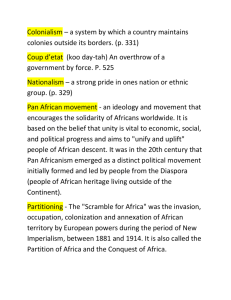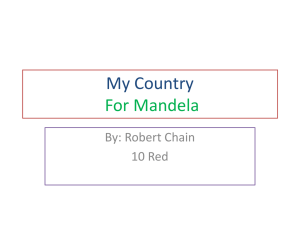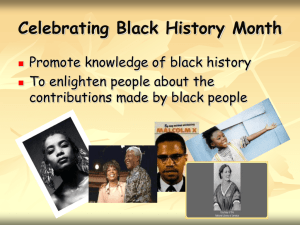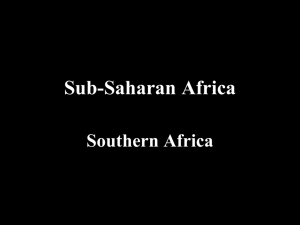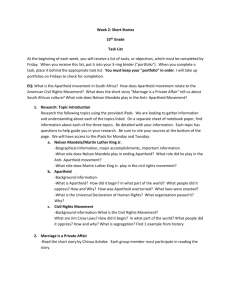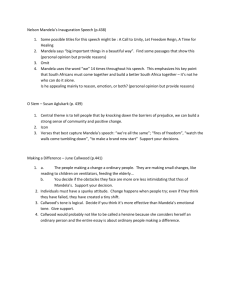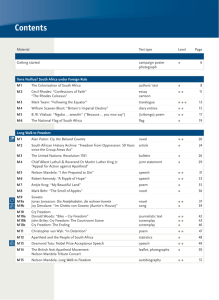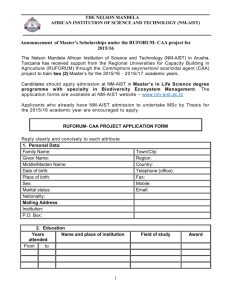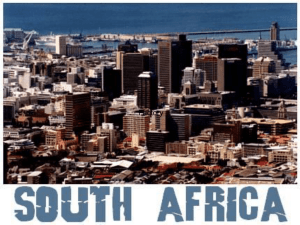Presentation Umea ppt
advertisement
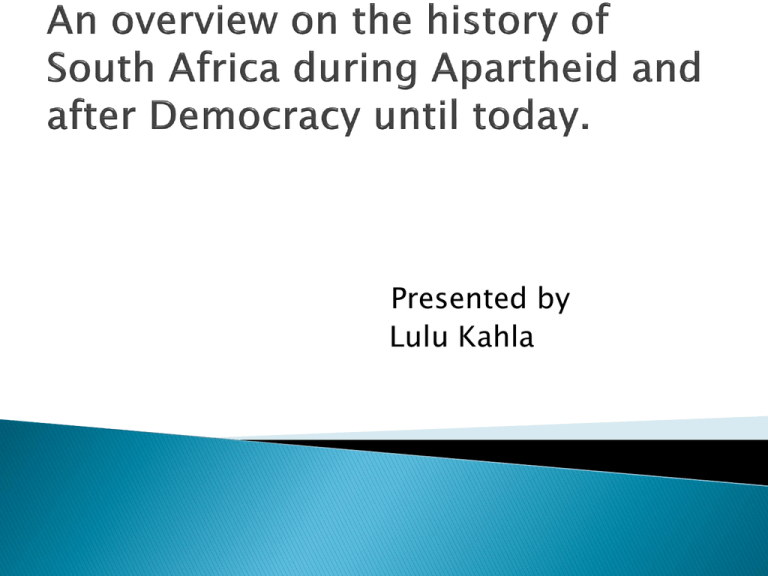
Presented by Lulu Kahla a) How was life in South Africa during the Apartheid Era. b) Changes were made after gaining Democracy in 1994. c) Challenges facing South Africa today d) How does AIDS influence education, educators and learners? e) Today’s vision about hosting the 2010 World Cup. The map of South Africa before 1994 ___________________________________________________________________ A map of South Africa before 1994, showing the original four provinces of the Cape, Orange Free State, Natal and Transvaal, as well as the grand apartheid "homelands" The Map of South Africa ___________________________________________________________________ Nine provinces Pretoria- Administration Cape Town –Parliament 2.7 times bigger than Sweden Population 49,3 million 1 Rand = 1 SEK Diversity of South Africa ___________________________________________________________________ LANGUAGE Data source: Statistics South Africa RELIGION Population of South Africa by Race ___________________________________________________________________ Population bay race Data source: Statistics South Africa The system of legal racial segregation was enforced by the National Party government in SA between 1948 and 1994 (46 yrs). The National Party legislation classified inhabitants into racial groups (‘black’, ‘white’, ‘coloured’ and ‘Indian’ In 1958 Blacks were deprived of their citizenship, legally becoming citizens of one of the ten tribally based self-governing homelands called bantustans. Created basis for ethnic government in African reserves or “homelands” Blacks had no rights in South Africa. Their rights were restricted to the so called “homelands”. The White Government had complete control over the homelands. By Mzoli Mncanca medical care and other public services and provided black people with service inferior to those of Whites Practical separation of residential areas Separation of public institutions e.g. schools and hospitals. Separation of jobs, ”jobs for whites only” Separate use of facilities like toilets, chairs, bus stops, stair-cases etc. Black buses stopped at black bus stops and white buses at white ones. Trains, hospitals and ambulances were segregated Prohibition of Mixed Marriages Act 55 of 1949, prohibiting marriages between white people and people of other races Blacks were not allowed to run a business in the areas that were meant for white South Africans. Colonialism and apartheid had an impact on women since they suffered both racial and gender discrimination. Women had few or no legal rights. No right to own property. Bantu Education Act (1953) gave the central government control over African education "Native education should be controlled . . . in accord with the policy of the state . . . If the native in South Africa today in any kind of school in existence is being taught to expect that he will live his adult life under a policy of equal rights, he is making a big mistake . . . There is no place for him in the European community above the level of certain forms of labor." -Hendrik Verwoerd, Prime Minister By Mzoli Mncanca Black students were forced to learn in Afrikaans. Protests against Afrikaans started. More than 500 black students killed by white policemen. More than a thousand men, women and children wounded. By Mzoli Mncanca 1969 Secrete agents involving a plot. 1982 Mandela including his collegues treferreed to Pollsmoor Prison. 1985 President P. W Botha offered conditional release for Nelson Mandela. Then, first meeting between Mandela and NP Throughout Mandela’s imprisonment, local and international pressure mounted on SA government to release him under the resounding slogan ”FREE NELSON MANDELA”. 1989, president Botha suffered a stroke, and was replaced by F W De Klerk 2 Feb 1990, FW De Klerk unbanned the ANC, 11 Feb 1990 releases Nelson Mandela. South Africa UBUNTU – ___________________________________________________________________ Democratic South Africa -HR ___________________________________________________________________ WWW.APARTHEIDMUSEUM.ORG 1994 – 1997 Nelson Mandela became the first Black President, FW De Klerk the first Deputy President and Thabo Mbeki the second. 1997 – 2006 then Thabo Mbeki become the second Black President and Jacob Zuma was a Deputy President. 2009 Jacob Zuma become the fourth Democratic President up until today after the Acting President Ralima Motlhale. High rate of unemployment Inequality with a racial overlay Lastly, poverty especially to those who were disadvantaged before democracy. In schools : Endemic to rural areas including overcrowding, poor school infrastructure (including collapsing ceilings and broken windows), high student to teacher ratio, long walk to get to school and lastly, the lack of teaching and learning resources. Violences in schools is increasing, Special needs and problems resulting from the HIV/ AIDS pandemic, social problems such as substance abuse. Non-governmental organisation are the main providers of children’ social welfare services and working along with the government. 2009 South Africa hosted the Configaration Cup in June, and results were good to see Bafana Bafana reach semi finals and playing with good teams such as SPAIN and BRAZILIANS 2010, from 11 June – 11 July again, SA will be hosting 32 best teams around the world and millions of spectators coming to watch those matches, ALL WHAT WE ARE SAYING WE ARE ALL READY AS SOUTH AFRICAN : The is still a long way to go for SA!! By Mzoli Mncanca

